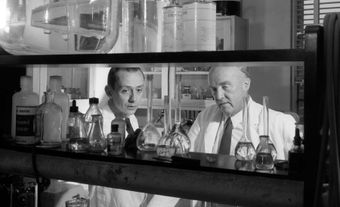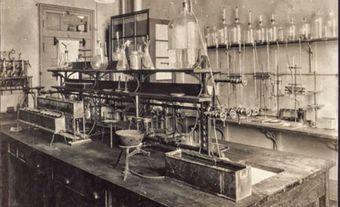Joseph Rolland Bernard Belleau, FRSC, OC, biochemist, medical chemist, (born 15 March 1925 in Montreal, QC; died 4 September 1989 in Sainte-Anne-des-Lacs, QC). Bernard Belleau was a Canadian pioneer in therapeutic chemistry, merging the fields of synthetic chemistry, biochemistry and pharmacology for use in medicine. He is acclaimed for his discovery and synthesis of the drug 3TC (2,3 dideoxy – 3-thiacytidine), also known as lamivudine or Epivir, used as an anti-viral for HIV/AIDS. He also developed butorphanol (Stadol), in the hope of having a non-addictive alternative to morphine, which is used to treat pain. Bernard Belleau’s discoveries have bettered human health and saved millions of lives globally.

Early Life and Education
Bernard Belleau was born in Montreal on 15 March 1925 to Marguerite Croteau (Quebec City) and Rolland Belleau (Plessiville, Quebec). Childhood interests and curiosities lead him to pursue a career in chemistry. He obtained a Bachelor of Science (1947) and Master of Science (1948) from the Université de Montréal. He graduated with a PhD in biochemistry in 1950, at McGill University, under the supervision of Dr. Robert Donald Hoskin Heard.
Career Highlights
In 1951, Belleau’s emerging talent was realized with the discovery of a new chemical reaction (the Fujimoto-Belleau reaction) used in the synthesis of steroid-based compounds. The Fujimoto-Belleau reaction was named after Belleau, while at the Sloan Kettering Institute, New York, and George Iwao Fujimoto, from the University of Utah.
By 1955, Belleau was hired as an assistant professor by Université Laval in Quebec City. It is there that he began his work on developing an alternative to the pain killer morphine.
Recruited to the Department of Chemistry of the University of Ottawa in 1958, his research focused on tailoring drugs to produce more effective medical therapies.
In 1971, Belleau returned to McGill University as a professor in the Department of Chemistry. His appointment by the Chair, Dr. Leo Yaffe, was an important addition in the development of this department.
The discovery of the analgesic butorphanol (a morphine-like painkiller) was made while Belleau was director of research at Bristol Laboratories of Canada in Candiac, on the South Shore of Montreal, in the early 1970s. The discovery was based on earlier work undertaken while he was at Université Laval in the early 1950s. In 1976, the American Chemical Society - Division of Medicinal Chemistry granted an award to Belleau for his research. This was the first time that an award from the American Chemical Society was given to a scientist outside of the United States. That same year, Belleau was also inducted into the American Chemical Society Hall of Fame.
In 1987, Belleau was appointed to the Institut Armand Frappier of the Université du Québec in Laval. The monumental discovery of 3TC occurred in 1989. The development of 3TC was undertaken by Belleau at IAF-Biochem International, a company he co-founded. This company became BioChem Pharma, one of Canada’s most successful biotech/pharma companies at the time. (See also Pharmaceutical Industry.)
Key Discoveries
Bernard Belleau designed the drug 3TC to address the human immunodeficiency virus, HIV, that causes AIDS. At the time, AZT (Zidovudine, Retrovir) was the only drug available to treat HIV. Belleau wanted to design a drug that would be better at preventing HIV infection.
Belleau designed the key modification by substitution of a sulphur atom for a carbon atom at the 3’ position of another nucleoside, deoxycytidine. This substitution stopped viral DNA synthesis (replication) in its tracks. (See also Virus.)

A key feature of Belleau’s new drug, 3TC, was an increased accuracy to target the HIV virus and prevent infection in patients. The combination of AZT and 3TC (sometimes they are combined with other drugs) is effective in blocking viral replication in infected cells.
With Dr. Mark Wainberg of the McGill AIDS Centre, Belleau developed the drug which remains an essential component of anti-retroviral therapy for tens of millions with AIDS globally.
Later Life
On 4 September 1989, Bernard Belleau died of a heart attack at his country home on Lake Marois in the Laurentians, north of Montreal. Belleau did not have the opportunity to see the fruits of his research and its global impact.
Together with Francesco Bellini and Gervais Dionne, IAF-Biochem International, which was founded in 1986, became Biochem Pharma in 1992. It was the impact of Belleau’s discoveries that provided the credibility for the creation of one of Canada’s most successful biotech companies until it was sold to Shire in 2000 for US$4 billion.
The Canadian Society for Chemistry has sponsored the Bernard Belleau Award and Lecture since 1983.
3TC is one of the antivirals used to treat AIDS/HIV and is listed as an essential medicine by the World Health Organization.
Did you know?
“…some day 3TC may be recognized as Canada’s most important medical contribution after the discovery of insulin in 1921.”
- Mark Wainberg, Director of the McGill AIDS Centre, in “Beating Aids: A ‘cocktail’ treatment of several drugs offers hope,” Maclean’s Magazine, 15 July 1996.
Honours and Awards
- Merck, Sharpe and Dohme Award, Chemical Institute of Canada (1962)
- Fellow, Royal Society of Canada (1968)
- Prix Acfas Léo Pariseau Medal, Acfas (1970)
- Division of Medicinal Chemistry Award, American Chemical Society Award (1976)
- Hall of Fame Inductee, American Chemical Society (Division of Medicinal Chemistry) (1976)
- Prix du Québec - Prix Marie-Victorin, Government of Quebec (1978)
- McLaughlin Medal, Royal Society of Canada (1979)
- Honorary Doctor of Science, Laval University (1979)
- Honorary Doctor of Science, Memorial University (1981)
- Officer, Order of Canada (1981)
- Honorary Doctor of Science, University of Camerino, Italy (1987)
- Armand-Frappier Institute Medal (posthumously) (1989)
- Prix Galien (posthumously), The Galien Foundation (1996)
- Inductee, Canadian Medical Hall of Fame (2000)

 Share on Facebook
Share on Facebook Share on X
Share on X Share by Email
Share by Email Share on Google Classroom
Share on Google Classroom







